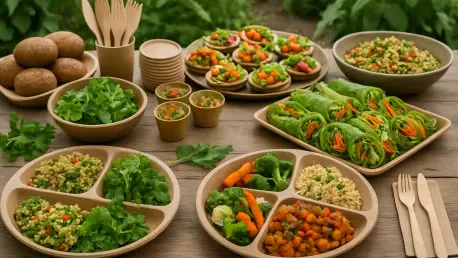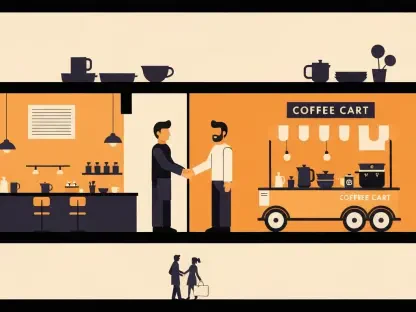Imagine hosting an event where every detail, from the food served to the packaging used, actively contributes to a healthier planet, cutting the environmental impact by nearly half compared to traditional methods. In an era where sustainability is no longer just a buzzword but a pressing necessity, the events industry is undergoing a significant transformation. Venues and caterers are stepping up to address the substantial carbon emissions tied to gatherings, with food and beverage services often being the largest contributors. Innovative approaches in catering are proving that it’s possible to host memorable occasions without compromising on environmental responsibility. This shift isn’t merely about optics; it’s about adopting practical, measurable strategies that redefine how events are planned and executed. Through pioneering partnerships and a commitment to systemic change, the industry is setting new benchmarks for what sustainable hosting can achieve.
Pioneering Sustainable Practices in Event Catering
Redefining Packaging with Innovative Materials
The journey toward sustainability in event catering begins with rethinking the materials used in food service, moving beyond superficial eco-friendly claims to solutions with real impact. Traditional options like polylactic acid (PLA) wraps, once hailed as green alternatives, often failed to decompose properly due to inadequate composting infrastructure, ultimately cluttering landfills. In response, forward-thinking caterers and venues have turned to alternatives like Proganic BOPP, a recyclable and biodegradable packaging material that breaks down without leaving harmful microplastics. After extensive testing, this option has emerged as a game-changer, demonstrating that scrutinizing the end-of-life impact of products is crucial. Such innovations highlight a broader industry push to prioritize accountability over marketing gimmicks, ensuring that every item used aligns with genuine environmental goals and reduces waste significantly at events of all sizes.
Shifting focus to implementation, adopting these materials requires a meticulous approach to supply chain management and client education. Caterers must work closely with suppliers to verify claims of sustainability, often conducting independent assessments to confirm that products meet strict environmental standards. Equally important is transparently communicating these choices to event planners and attendees, fostering trust and encouraging wider adoption of green practices. This process isn’t without challenges—higher upfront costs and limited availability of cutting-edge materials can pose barriers. Yet, the long-term benefits, including reduced landfill contributions and lower carbon emissions, far outweigh initial hurdles. By integrating such solutions into standard operations, catering services can set a precedent for others in the industry, proving that small changes in material selection can yield substantial environmental gains over time.
Emphasizing Plant-Based Menus for Lower Emissions
Another cornerstone of sustainable catering lies in transforming dietary offerings to prioritize plant-based options, a move that directly tackles the high carbon footprint of food production. With over 70% of menus at leading venues now featuring vegetarian or vegan dishes, there’s a clear trend toward making these choices the default rather than the exception. Livestock farming, a major source of greenhouse gases, can be significantly curtailed by this shift, as plant-based foods typically require fewer resources and emit less pollution. This isn’t about sacrificing flavor or variety; modern culinary techniques ensure that these dishes are as appealing and satisfying as their meat-based counterparts, meeting the expectations of diverse audiences while aligning with environmental priorities.
Beyond menu design, the adoption of plant-based catering involves rethinking sourcing and preparation methods to maximize sustainability. Local, seasonal ingredients play a critical role, reducing transportation emissions and supporting regional farmers who often employ eco-friendly practices. Caterers are also minimizing food waste by carefully planning portion sizes and repurposing leftovers into creative dishes or donations. Education remains key—informing clients about the environmental benefits of plant-based choices helps shift perceptions and encourages broader acceptance. As more events showcase the viability and appeal of these menus, the ripple effect across the industry could lead to a lasting reduction in food-related emissions, making every gathering a step toward a greener future.
Building Systemic Change Through Collaboration
Fostering Partnerships for Industry-Wide Impact
Sustainable catering isn’t a solo endeavor; it thrives on strategic collaborations that drive innovation and set new standards for the events sector. Partnerships between venues and caterers, built on shared values of environmental responsibility, have proven instrumental in challenging outdated practices. These alliances focus on integrating sustainability into every operational facet, from using recycled glassware to implementing zero-waste packaging solutions. By working together, such teams have not only rewritten benchmarks for sustainable event management but also inspired measurable outcomes like reduced food-related emissions. This collaborative model serves as a blueprint, showing that aligning with like-minded suppliers willing to test novel approaches can amplify impact far beyond a single event.
The ripple effect of these partnerships extends to influencing broader industry norms and client expectations. When leading venues and caterers demonstrate that sustainability enhances rather than detracts from the event experience, they create a compelling case for others to follow. Transparency with clients—sharing data on carbon savings and waste reduction—builds credibility and fosters demand for greener options. Additionally, joint efforts often lead to advocacy for better infrastructure, such as improved composting facilities, which address systemic gaps. As more players in the events space witness tangible results from these collaborations, the momentum for adopting sustainable practices grows, paving the way for a collective shift toward accountability and real progress in reducing environmental footprints.
Moving Beyond Greenwashing to Tangible Results
The events industry has long grappled with greenwashing, where superficial claims of eco-friendliness mask a lack of substantive action, but a new wave of accountability is changing the narrative. Sustainable catering now demands rigorous scrutiny of supplier promises and the establishment of concrete, measurable goals to ensure genuine impact. This means looking past trendy labels to assess the full lifecycle of products and services, ensuring they don’t just appear green but deliver on their promises. Venues and caterers leading this charge have shown that prioritizing transparency and results—whether through cutting packaging waste or halving food emissions—can redefine what events contribute to the planet’s health, setting a higher standard for all.
Reflecting on past efforts, it’s evident that the commitment to tangible outcomes shaped a path forward for many in the sector. By focusing on innovations like biodegradable materials and plant-based menus, industry leaders tackled practical challenges head-on, achieving significant reductions in carbon footprints. These successes weren’t just milestones; they became lessons in the power of dedication and systemic integration. Looking ahead, the next steps involve scaling these practices, advocating for supportive policies, and investing in technologies that further minimize waste. As the industry continues to evolve, embracing such actionable strategies ensures that sustainability remains a core value, transforming every event into an opportunity for meaningful environmental progress.









